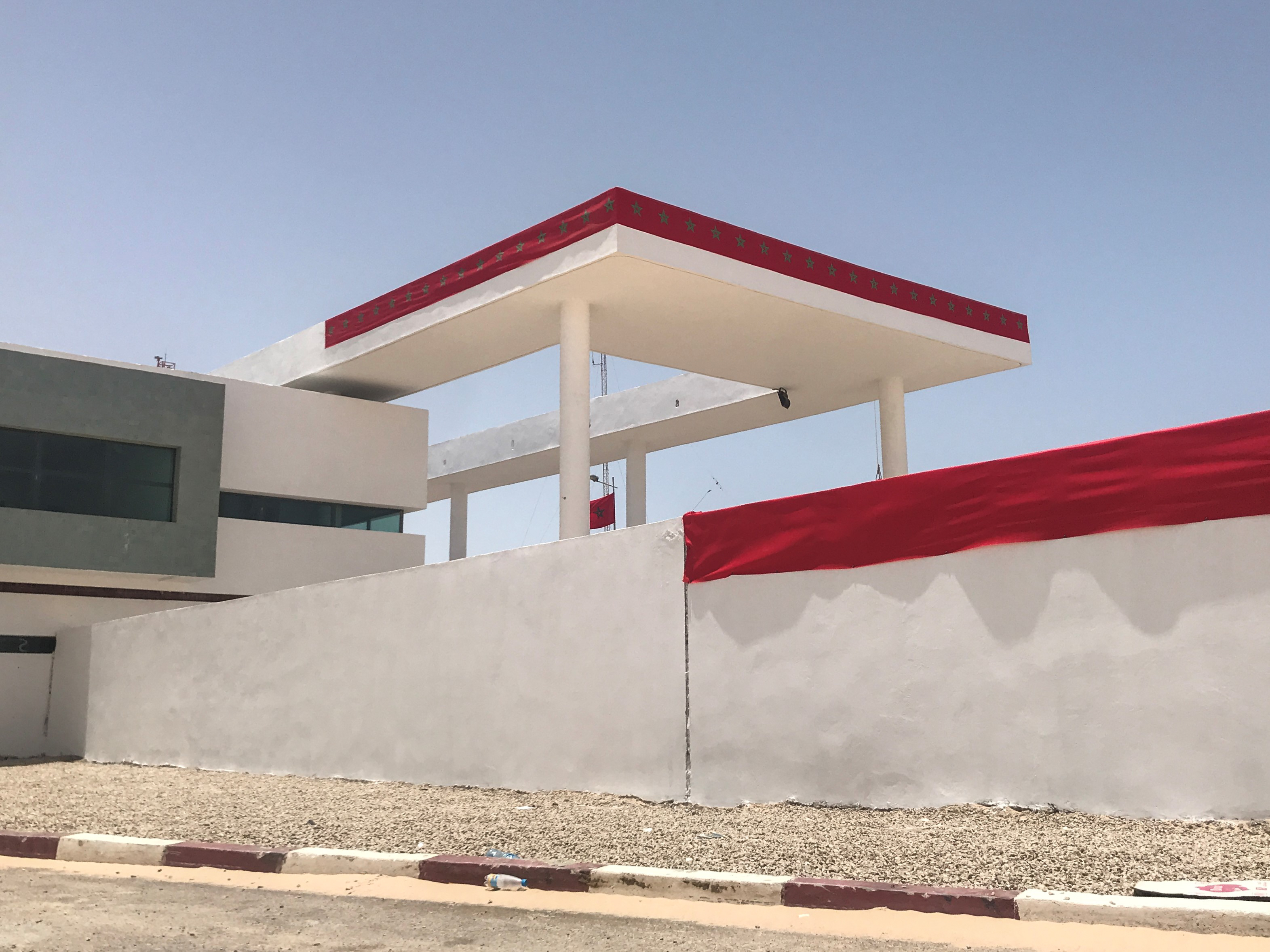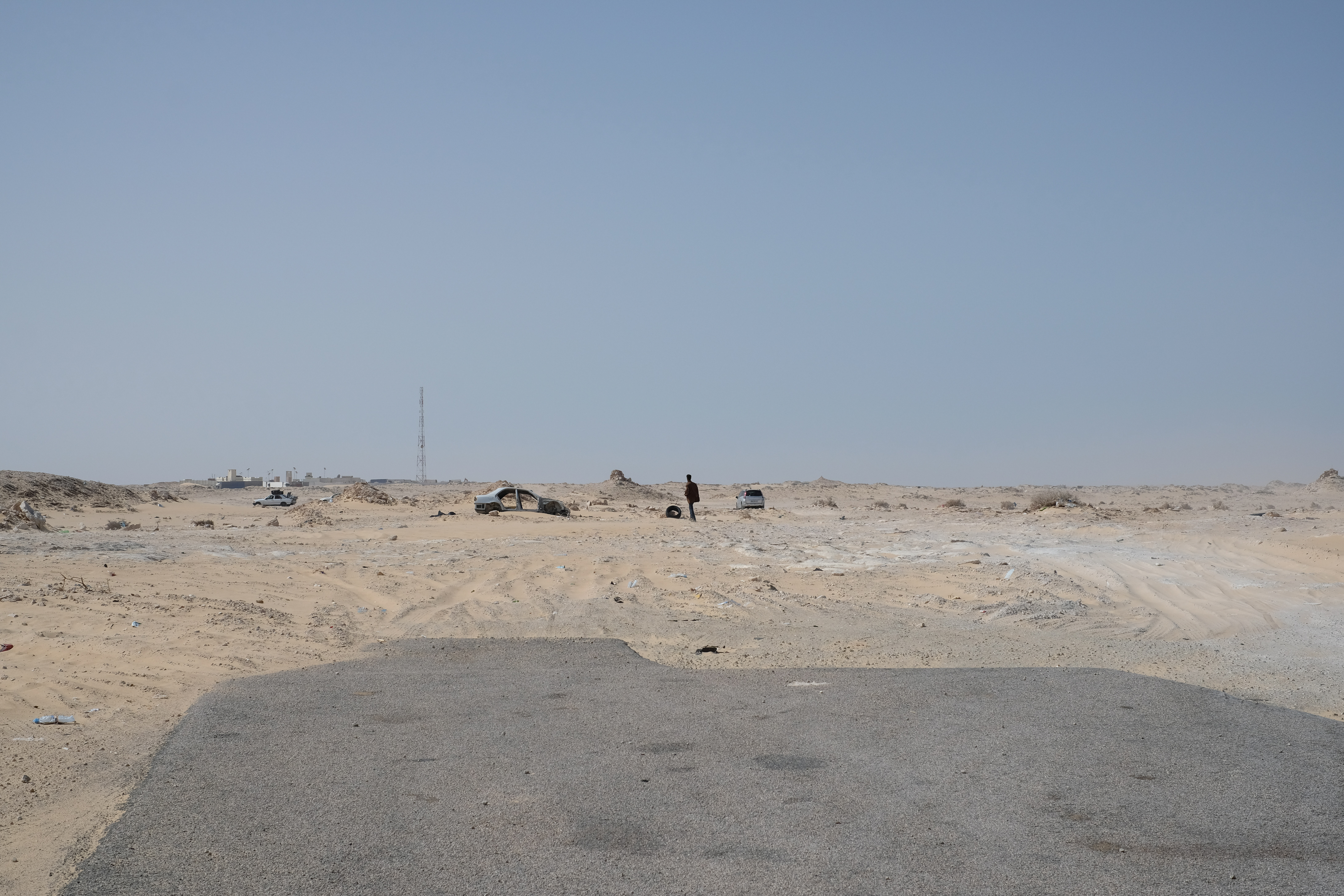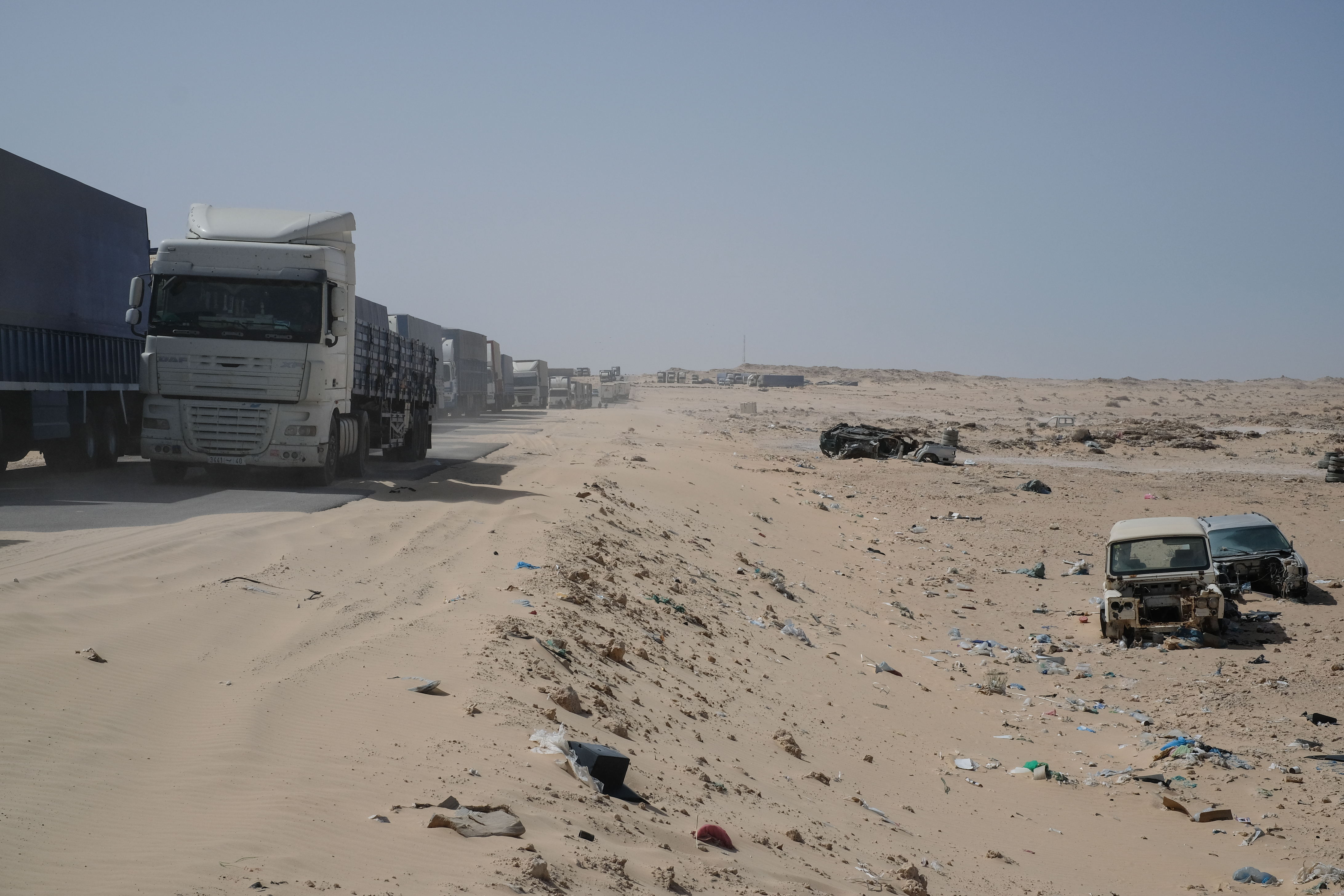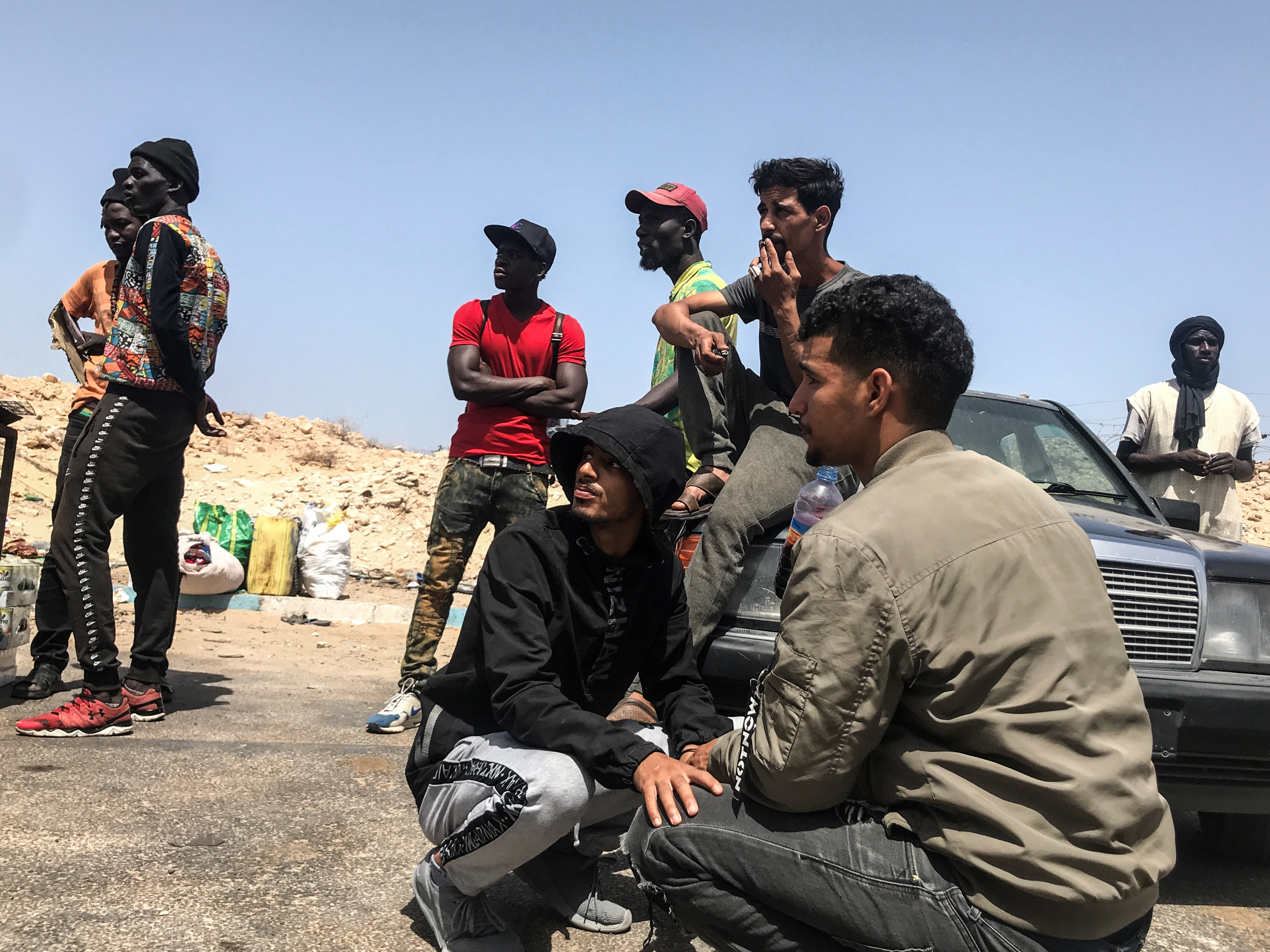GUERGUERAT
-
COUNT DOWN TO
A FAILURE

















After 29 years, the cease-fire between Morocco and the Polisario Front was broken on November 13, 2020 in Western Sahara. The Moroccan military incursion into the buffer zone of Guerguerat is a violation which has triggered the resumption of the armed conflict.

Western Sahara is considered as the last remaining territory to be decolonized on the African continent. Formerly a Spanish colony it was illegally annexed by Morocco in 1975, following the Green March.
After 16 years of war between Morocco and the Polisario Front, a ceasefire was signed in 1991. The United Nations was then asked to organize a referendum in order to respect the inalienable right of the Saharawi people to self-determination (MINURSO, United Nations Mission for the Organization of a Referendum in Western Sahara).
However, since 1991, a status quo has prevailed, allowing the Moroccan occupation to intensify in defiance of international law.
♦

When the ceasefire was accepted in 1991, by both the Polisario Front and Morocco, it was to be accompanied by the signing of military agreements (in 1997 and 1998) which introduced a number of restrictions in order to allow a transitional context conducive to the organization of the self-determination referendum.
This referendum should allow the people of Western Sahara to choose between independence or integration into Morocco.
By signing the military agreements, the three parties (MINURSO, Front Polisario, and Royal Moroccan Armed Forces) undertake to honor commitments.
Military Agreement No. 1 thus delimits the distribution on the territory of the two armies and the zones of restrictions (see maps). This transitional distribution of the territory is based on the delimitation of the 2,500 km military wall built by Morocco in the 1980s - to protect “its space” considered “useful” (exploitation phosphates and fish).
The referendum was initially scheduled for 1992, but the UN mission was initially faced with obstructions, delays and then failures.
The MINURSO mandate is to:
- Monitor the ceasefire
- Verify the reduction of Moroccan troops in the territory
- Monitor the confinement of Moroccan and Polisario troops to designated locations
- Take steps with the parties to ensure the release of all Western Saharan political prisoners or detainees
- Oversee the exchange of prisoners of war (through the International Committee of the Red Cross)
- Implement the repatriation programme (through the United Nations High Commissioner for Refugees)
- Identify and register qualified voters
- Organize and ensure a free and fair referendum and proclaim the results
The outcome after 29 years is disastrous, and inevitably questions the responsibility of each party, mainly the UN Security Council and the MINURSO, given the supposed neutrality to accompany these functions.
- The ceasefire was quickly violated on both sides (FAR Maroc and Polisario Front).
- No date has been set for a referendum (partly due to the Moroccan obstructions backed by France, a permanent member of the UN).
The persistence of Moroccan obstruction has established a status quo in favor of Morocco. Faced with the immobility of the UN, Morocco has continued illegally via "fait accompli" tactics (inaugurated with the Green March) the extension of its occupation on the territory, massive Moroccan settlement, and the exploitation of natural resources.
The occupation benefits from a growing normalization and legitimization resulting from numerous bilateral cooperation agreements signed between Morocco and the Western countries - not to mention the EU-Morocco partnerships allowing the illegal exploitation of the resources of the Sahara (see reports).
The Moroccan invasion in 1975 forced the Sahrawi population out of its territory, towards refugee camps in the Algerian desert. The Saharawis who remained in the occupied territory are therefore a minority subjected to repression by the Moroccan authorities. The various mechanisms of occupation over this land, and the oppression on the Sahrawi minority, has aimed to eventually reach a point of no return: the irreversible "Moroccanization" of Western Sahara and to render the right of the Sahrawi people to a referendum of self-determination obsolete.
The progression in the UN Secretary General's Reports between 1990 and 2020 underline the shortcomings of this UN mission. Moreover, the mention of a self-determination referendum disappears altogether from the resolutions, its role being limited for the last ten years to listing the violations of the ceasefire, without any real intervention on the ground, nor taking into account the Moroccan settlement and the exploitation of resources which directly impact the resolution of the conflict.
♦
The Guerguerat crossing point is extremely strategic on several levels and tensions have been building up there for several years.

An April 2001 report from the UN Secretary General mentions that the Moroccan army plans to build an asphalt road through the buffer zone, and the UN warns Morocco that "the proposed construction posed delicate problems and that some activities undertaken could contravene the ceasefire agreement”. The following report in June 2001 states: "various signs indicating a resumption of works, MINURSO and several member states contacted the Moroccan authorities and requested that they once again suspend the construction works of this road".
The following reports no longer mention Guerguerat.
We must wait for the 2017 report which details the tense face to face between Morocco and the Polisario Front.
In August 2016, the Moroccan authorities entered the buffer zone to supervise the construction of a road leading to the Mauritanian border post. The forces of the Polisario Front intervene to stop this work. Both sides then violated military agreement No. 1.
This tense face to face will last until February 2017.
The Polisario Front's argument on its lasting presence in the buffer zone was above all to put pressure on MINURSO to protest against the opening of the military wall by demanding "a solution that goes beyond a simple recording of violations".

It is difficult to know exactly when this breach was opened on the military wall.
MINURSO has long been overwhelmed on the ground given the number of violations of Military Agreement No. 1 on both sides due to the limited number of military observers and bases over a very wide area of responsibility (The report by April 2005 of the Secretary General of the UN admits some weaknesses on this point).
In 2005, satellite views show that Morocco rearranged the national road between Dakhla and Guerguerat, that a breach was opened in the military wall to create a passage into Mauritania (illegal), that a Moroccan customs post was built , and that the Mauritanian border post is installed in the buffer zone in Western Sahara.
Before January 2002, crossings from Dakhla to Nouadhibou were limited to as it was accompanied by a military convoy (Moroccan then Mauritanian) twice a week. The convoy had to bivouac at night in a military camp in Guerguerat. The absence of tar on the Mauritanian side until 2005 reduced any development, it took a day to drive from Guerguerat to Nouadhibou.
From 2005, Morocco clearly aimed to develop this land border to make it a “commercial corridor” towards Sub-Saharan Africa. Military Agreement No. 1 does not concern civilian activities and therefore does not prohibit civilians from entering the buffer zone. However, opening a breach in the military wall is a violation. Consequently, the civil or commercial passage (import-export) is illegal until the conflict is resolved.
♦
Since 2017, roadblocks by Sahrawi civilians in this area have been very frequent, of varying duration, ranging from one day to several weeks. The blockades cause strong tensions between the Sahrawis, and Mauritanian traders, sub-Saharan travelers, truckers - and the Moroccan police.
MINURSO forces are not very present on the spot. In the absence of a base in this area, they stay in a hotel located 80km to the North (on the N1 at Bir Gandouz). Consequently, the Moroccan authorities have free rein to operate illegally.

The death of Ahmed Salem Ould Ahmed Ould Lemgheimadh in February 2019 is the result of impunity for Moroccan violations in this area.
On January 27, 2019, this young 24-year-old Sahrawi trader blocked traffic in the buffer zone, to protest against the unfair treatment he received from Moroccan customs. Surrounded by injustice and police oppression, he immolated himself and died 3 days later.
A gesture that expresses his despair in the face of the injustice brought about by colonialism. In a video that precedes his act, he calls for help and expresses his exasperation with the socio-economic exclusion of Sahrawi youth in the occupied territory : “Please find a solution for us! Show your solidarity with us. We just want to work. We just want a piece of bread ”.
In reaction to the violence of this death, the representative of the Polisario Front at the United Nations, Mr. Sidi M. Omar, expressed his concern to MINURSO about the Moroccan police intrusions in the buffer zone and stressed that these violations of the ceasefire endangered the Sahrawis : “This situation can no longer be tolerated and the UN must assume all its responsibilities and ensure full respect for the ceasefire. ".
But their criticisms are met with UN silence and passivity
But their criticisms are met with UN silence and passivity
♦
As the years go by, the Sahrawis have lost faith in MINURSO. International law is on the side of the Sahrawis. However, these rights are trampled on.
Since the resignation in May 2019 of Personal Envoy Horst Kohler, this post at MINURSO has remained vacant, therefore no progress is possible at the UN level.
The Secretary General's latest reports are unbalanced (a point underlined by Russia and South Africa in the UN Security Council).
Self-determination and the inalienable right of the Sahrawis are discredited in favor of a "mutually acceptable compromise", an inappropriate terminology in the case of decolonization.
November 13, 2020 therefore marks a breaking point, the leadership of the Polisario Front considers that they have no other choice but to take up arms again to enforce respect for the rights of the Saharawi people.
It should be noted that the 29 years that precede are quite surprising. It is rare to see a people show so much patience and such a strong commitment to a diplomatic settlement.
For years many youths (especially on the refugee side) had been calling for war. Now that the war has resumed, some young people finally consider it an honor to take up arms only after having distinguished themselves by an exemplary lengthy non-violent struggle for the respect of their rights.
Peaceful recourses are now slim as the diplomatic struggle has come up against complacency, lobbies and political manoeuvring by foreign powers to bypass inalienable rights.
♦
The peaceful citizen mobilization which precedes November 13, 2020 is quite unprecedented in that it is engaged simultaneously on different fronts (occupied territory, refugee camps, territory under Polisario control) and benefits from a surge of enthusiasm suggesting no going back.
On September 20 (10 years after the Sahrawi protest encampment in Gdeim Izik), around thirty activists met clandestinely in Laayoune to launch ISACOM, the Sahrawi Instance Against the Moroccan Occupation.
Its goal is to peacefully defend the rights of the Sahrawis to freedom, independence and dignity - and to reject occupation and the status quo. It condemns the responsibilities of the UN, MINURSO, and France in this current impasse.
The clandestine launch of this new organisation took weeks of planning in order to successfully thwart Moroccan police surveillance. In this occupied territory, recognizing the existence of Western Sahara as an entity distinct from Morocco is a Moroccan criminal offense punishable by imprisonment for "undermining the internal security" of Morocco.
The Moroccan authorities have responded by opening a judicial investigation and increasing the police presence and oppressive measures throughout the city. The homes of activists are surrounded 24 hours a day by a police blockade (DGSN and DGST) preventing access.
On the other side of the wall, on September 23, dozens of civilians left Tindouf refugee camps with the goal of blocking the passage to Guerguerat indefinitely. About 1,500 km of tracks in mined territory separate them from this buffer zone. The blockage whose stated ambition was clearly to put pressure on the UN was initially scheduled to coincide with the 75th session of the UN General Assembly, followed by the renewal of MINURSO in the UN Security Council .
The initiative created a buzz on social networks (but encountered some divisions among Polisario leaders).
On the same day, UNESCO included Laayoune in its list of “Moroccan cities that are members of the Global Network of Learning Cities” (GNLC). An absurdity that insults the Sahrawis, knowing that UNESCO is part of the UN, that Laayoune is a city under Moroccan occupation (and not in Morocco), and that the colonial policy seeks to destroy the Sahrawi identity, culture and history. Faced with the mobilization of associations, UNESCO discreetly withdrew Laayoune from the list the following day, without making any apologies to the Sahrawis. (Audrey Azoulay is the director of UNESCO - daughter of André Azoulay, advisor to King Hassan II, then Mohammed VI)
On October 10, around ten Sahrawis settled to demonstrate in the buffer zone. A second group of protesters arrived on October 12 from the refugee camp, followed by another group later.

At the same time, sit-ins were taking place directly on the separation wall, on October 19 near M’Hiriz and on October 21 near Bir Lahlou (territory under the control of the Polisario Front). Dozens of men and women demonstrated with flags, facing the Moroccan military. (The separation wall has around 100,000 Moroccan soldiers spread over hundreds of observation posts. The surroundings of the wall are mined).
The complete blockade of passage through the buffer zone began on October 21 and was accompanied by peaceful protests with messages to the UN and the EU calling for:
- closure of this breach on the separation wall
- the end of resource exploitation
- the organization of the self-determination referendum (and the end of the status quo)

The blockage quickly generated heavy financial losses especially for Spanish and Moroccan fishermen (who export via Guerguerat), a shortage of fruits and vegetables throughout Mauritania (which suffers from a rise in prices and the dissatisfaction of the inhabitants), and the blocking of a hundred discontent Moroccan truckers (on either side of the border posts).

On October 21, the spokesperson for the UN Secretary General made a statement in favor of Morocco :
"We must remind that regular civil and commercial traffic must not be hampered (in Guerguerat) and that no measure must be taken which could constitute a change in the status quo in the buffer zone" of Guerguerat ".
Meanwhile spontaneous demonstrations take place in the occupied territory every evening despite persistent police violence and arrests.
On November 6, Moroccan military reinforcements entered the restricted area of Guerguerat and positioned themselves on the wall (November 6 is a Moroccan national holiday which celebrates the Green March and symbolizes "the recovery of the Moroccan Sahara"). The Polisario Front emphasizes this violation of the ceasefire to MINURSO. The UN remains silent on this point.
In the refugee camps, speeches and rallies muster the population against the Moroccan occupation.
As always, the videos go back and forth via phone throughout the Sahrawi community (refugee camps in Algeria, Mauritania, occupied Sahara, and among refugees in Europe).
On November 9, the Polisario Front warned, via a press release, that "the entry of any Moroccan military, security or civilian element" into the buffer zone would be considered "a flagrant aggression, to which the Sahrawi party will respond vigorously, in legitimate defense and defending its national sovereignty ”.
On November 11, a demonstration was organized in front of the MINURSO headquarters in the town of Mijek (territory under Polisario control) to demand the organization of a self-determination referendum.
On November 12, several Sahrawi refugee camps in Algeria (Rabouni, El Aaiún) demonstrated against the Moroccan occupation.
A night-time demonstration in the refugee camps calls for freedom or war.
On November 13, Moroccan forces entered the buffer zone to disperse the peaceful Sahrawi demonstrators. The reopening of "the civil and commercial passage" is used as a pretext to justify the military operation (military agreement No. 1, signed by Morocco, specifies that the buffer zone is prohibited access to the military).
Moroccan Foreign Minister Nasser Bourita explains that "Morocco has decided to act, in accordance with its attributions, by virtue of its duties and in full compliance with international legality". In reality, international law opposes Moroccan occupation, colonization, or the exploitation of resources in this non-self-governing territory.
Polisario soldiers intervene to escort the demonstrators to safety.
The Polisario Front declares that the ceasefire "has been liquidated".
Morocco accustomed for years to the endless threats from the Polisario to take up arms again, does not seem to have given much importance to this threat, probably calling it bluff (see the threat of resumption of arms during the passage on the military wall of the Paris-Dakar Rally in 2001).
The announcement of the resumption of arms seems to surprise Morocco at first. Attached to the status quo and to the invisibilization of violations on the ground, the resumption of the armed conflict introduces the risk of media interest making the facts visible, and of the signing of a new ceasefire which would this time include a monitoring of human rights. In addition, the resumption of the armed conflict also offers Morocco the possibility of extending the occupied territory beyond the wall to reach the locality of Lagouira, then the whole of the Sahara eventually.
On November 17, Morocco built a new separation wall on the buffer zone to protect the passage to Mauritania - which constitutes an illegal extension of the occupied territory, aggravated by the laying of mines along this wall (Morocco did not not ratify the Anti-Personnel Mine Ban Convention).
The same day, the French Ministry of Foreign Affairs declared :
“France is closely monitoring events in Guerguerat. It has publicly expressed its concern [during Le Drian's visit to Morocco on November 9-10] over the blockade of this border crossing and reaffirms the importance of the free movement of goods and people in the area. It takes note of the measures taken by Morocco.France welcomes Morocco’s commitment to the ceasefire. It must be preserved, just as the political process must be revived within the UN framework.”
This declaration favors a commercial flow of goods to the detriment of the Sahrawis' right to freely self-determine their future. The rhetorical emphasis on "Morocco's attachment to the ceasefire" helps to conceal Morocco's direct responsibility for the resumption of armed conflict.
On the UN side we note an absence of pressure on Morocco regarding the opening of this breach, the extension of the military wall in the buffer zone, and its direct responsibility in the collapse of the ceasefire.
Since 2015, civil blockades have been very frequent throughout the year.
The UN regularly holds the Polisario Front responsible for blockades "on civil and commercial traffic", not to mention that this opening on the military wall is a fait accompli that violates the ceasefire and opens up additional problems. This speech illustrates a UN bias on this border area of Guerguerat, and gives an overview of the diplomatic impasse of the Sahrawis today.
After 10 days of fighting, the UN remains discreet fairly silent and withdrawn.
♦
The Sahrawi population in the occupied territory is the main victim of this armed conflict, enclosed in towns monitored by the police and auxiliary forces.
Violence, abuses, arbitrary arrests, kidnappings, enforced disappearances, torture, raids by special forces on the homes of journalists, blockades around the homes of activists, obstruction on leaving the territory, death threats, intimidation ... Minors, the elderly, girls or boys - police violence causes victims without distinction and revives the specter of the enforced disappearances of the years 1976-92.
Human rights violations accumulate with increasing impunity given the media blockade on the territory and the inaction and silence of the international community that prevail.
Hayat Moulay Ahmed Sidiya, 12-year-old Saharawi, denounced by the management of her school in Laayoune was carted off by the police. She was beaten and psychologically oppressed for having drawn a Sahrawi flag on her blouse. Police forced her to sing the Moroccan national anthem and to kneel in front of a portrait of King Mohammed VI to repeat "Long live the king, long live the Moroccan Sahara"
This UN mission is unique in having no human rights monitoring mandate due to France's veto in the Security Council. MINURSO personnel in Laayoune are entrenched in their base for security measures and observe a ceasefire that has already been shattered.
The Charter of the United Nations and the most elementary ethical principles have been trampled on for 29 years and result in part from the influence of France and the United States on the resolutions of the Security Council, and their respective and self-serving complicity with Morocco (arms sales, military cooperation, anti-terrorism, trade, etc.).
Given Morocco's impunity and the paralysis of the UN for three decades, the Sahrawis point out the responsibilities that have led to their persistent vulnerability and call on the media to report on their predicament despite the media blockade imposed on them by Morocco (see the RSF file “Western Sahara, a desert for journalists”).
On social networks videos, alerts and requests from the Sahrawis increasingly request the urgent intervention of the International Red Cross (ICRC) in order to impose respect for the Fourth Geneva Convention on the protection of civilians in time of war . Invariably, “Peace, justice and freedom” are demanded by the Sahrawis.
A future cease-fire is essential, but how can the UN be trusted when it has discredited itself in the eyes of the Sahrawis? And how can this conflict be resolved without returning to the status quo?
Photos :
Guerguerat, 2016 - 2019
WhatsApp, 2020